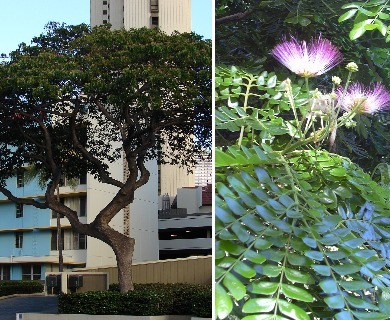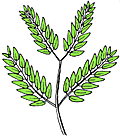Monkeypod
Samanea saman
Pea family (Fabaceae)
Post-Cook introduction
Monkeypod is a familiar beautiful shade tree with large trunk and very broad arched of dense foliage. It has leaves with many paired diamond-shaped that fold together at night and on cloudy days. The flower heads are a mass of threadlike pink in outer half and white in inner half, and the flattened brown or blackish pods with sweetish pulp do not open. Mimosa subfamily (Mimosoideae).

©2007 Forest And Kim Starr
Leaves 10–16 inches (25–40 ) long. The axis and 2–6 pairs of branches () are green and finely hairy with swelling at base of each and dot on axis where branches join. Each branch bears 6–16 paired stalkless with a dot between each pair. Branches toward the are longer, with more blades 3⁄4–1 1⁄2 inches (2–4 ) long and 3⁄8–3⁄4 inches (1–2 ) broad, the outer largest, blunt with minute point at short-pointed at base, not on edges, the sides unequal, slightly thickened, upper surface shiny green and lower surface paler and finely hairy.
Flower clusters (heads or ) several near end of twig, each on green hairy stalk of 2 1⁄2–4 inches (6–10 ), about 2 1⁄2 inches (6 ) across and 1 1⁄2 inches (4 ) high, composed of many short-stalked narrow tubular pinkish flowers tinged with green. The narrow green is tubular, about 1⁄4 inch (6 ) long, five- finely hairy; the narrow pink and greenish tinged 3⁄8–1⁄2 inch (10–13 ) long, tubular, five- and finely hairy; many united in tube near base, with spreading very long threadlike filaments about 1 1⁄2 inches (4 ) long, ending in dot-like delicate and soon wilting and shriveling; and consisting of one-celled light green 3⁄16 inch (5 ) long and threadlike pinkish 1–1 1⁄4 inches (2.5–3 ) long. Flowering from April to August in Hawaii.
Pods narrowly oblong, 4–8 inches (10–20 ) long, 5⁄8–3⁄4 inch (15–19 ) wide, and 1⁄4 inch (6 ) thick, with raised border, straight or a little curved. Seeds are several, beanlike, oblong reddish brown, about 5⁄16 inch (8 ) long.
Sapwood is thin and yellowish and heartwood dark chocolate brown when freshly cut, becoming an attractive light to golden brown with darker streaks. The wood is moderately hard, lightweight ( gr. 0.52), of coarse texture, and fairly strong. It is resistant to very resistant to decay and resistant to dry-wood termites. It takes a beautiful finish but is often -grained and difficult to work. The wood shrinks very little in drying and consequently can be carved into bowls while green and dried later without serious degradation. Machining characteristics made on wood of low density in Puerto Rico were as follows: planing, mortising, sanding, and resistance to screw splitting were good; shaping and boring were fair; and turning was poor. When green, Hawaii-grown monkeypod turns very well. It is the wood around which the carved bowl trade of Hawaii was built beginning in 1946. The wood has been employed occasionally for furniture, interior trim, and flooring. It is a popular wood for large frame members in wooden boats. It is suitable also for boxes and crates, veneer, plywood, and paneling. In Central America, sections of thick trunks have served as wheels of ox carts.
Souvenirs made from the golden brown wood with darker streaks have been purchased in quantities by tourists in Hawaii. Beautifully polished bowls and plates of various sizes and shapes are in demand. However, at present, most of these bowls are made in the Philippines, Thailand, or Malaysia, where monkeypod is also plentiful. Seeds are used in leis.
Monkeypod was introduced to Hawaii in 1847 by Peter A. Brinsmade, then consul from the Kingdom of Hawaii at Mexico City, who brought in two seeds. One became a tree which was at Bishop and Hotel Streets in downtown Honolulu until 1899, when it was cut down to permit construction of a building. The other seed was planted at Koloa, Kauai, and produced a tree that was the parent of a large stand of monkeypod there (Anon. 1938).
The trees in Hawaii are valued mainly for shade and beauty. The nutritious pods are relished by cattle, hogs, and goats. Some people chew the pods for the sweetish flavor like licorice. The tree is a honey plant. In a few countries this species has been employed as shade in plantations of coffee and cacao, but less so now than formerly. Because of their enormous growth the trees compete heavily for water and soil nutrients, inhibiting the shrubs planted beneath. The trees are easily propagated from seed and cuttings and grow rapidly. Cattle disseminate the seeds in pastures.
Monkeypod is a favorite shade tree of streets and parks in lowlands of Hawaii and is planted and naturalized in pastures. Because of its large size it is less suited for planting around homes. Sometimes trees become topheavy and dangerous along highways and near houses. The many surface roots may also be objectionable. The trees are also messy, dropping sticky flower parts and pods on cars parked beneath. Perhaps the species is better suited to dry localities, where the size is smaller.
Special areas
Keahua, Foster
Champion
Height 104 ft (31.7 ), c.b.h. 30.8 ft (9.4 ), spread 140 ft (42.7 ). Kohala Forest Reserve, Muliwai, Hawaii (1968). A very large monkeypod in Moanalua Gardens, Oahu, has a that covers over 3⁄4 acre (0.3 ha).
Range
Native from Mexico (Yucatan Peninsula) and Guatemala to Peru, Bolivia, and Brazil. Widely planted and naturalized elsewhere in continental tropical America from Mexico southward, throughout the West Indies and in Old World tropics. Common in Puerto Rico and the Virgin Islands and grown also in southern Florida.
Other common names
raintree; saman (Puerto Rico, Spanish); licorice, giant tibet (Virgin Islands); gumorni spanis (Yap)
Botanical
Albizia saman (Jacq.) Polhill & Raven, Pithecellobium saman (Jacq.) Benth.
The Spanish word “saman” and the specific name are from a South American aboriginal name. Several origins of the English word raintree and its French equivalent have been given. Early travelers reported that the tree mysteriously produced “rain” at night and would not sleep underneath it. Others observed the grass to be greener beneath the trees during droughts. Probably, the “rain” was the excreta of cicada insects inhabiting the trees. The Spanish name dormilon refers also to the movements of the which close in the dark, suggesting sleep at night. In drought areas, grass is often green under the large spreading crowns while grass in the open is brown, simply because it is exposed to the sun. Insects defoliate many trees each spring, but trees recover leaves rapidly.
Earpod-tree (Enterolobium cyclocarpum (Jacq.) (Griseb.) is a similar giant tree introduced for shade and ornament in Hawaii, mainly in dry lowlands. This tree is recognized by (1) short stout trunk with gray bark and thin spreading broader than high; (2) twice- leaves with numerous paired oblong 3⁄8–1⁄2 inch (10–13 ) long; (3) flowers in whitish balls about 1 inch (25 ) across numerous threadlike white and (4) very distinctive blackish seed pod, flattened and curved in a circle 3 1⁄2–4 1⁄2 inches (9–11 ) in diameter, slightly resembling an ear. Planted as a street tree in Hawaii, growing rapidly but large for use around homes. A very large tree is in Foster Botanic Garden, Honolulu. Under the Spanish names guanacaste and genicero, the wood is used elsewhere for construction, carpentry, interiors, furniture, and veneer. Native from Mexico south through Central America to northern South America and introduced as a shade tree in other tropical regions.










